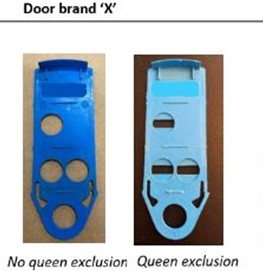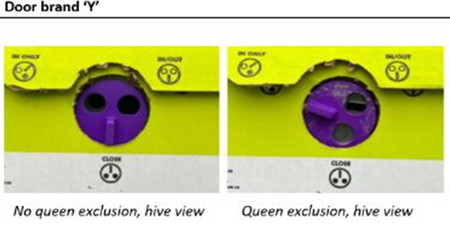Commercial Bumble Bee Management Practices
By University Extension Specialists Laura Johnson (UVM), Lisa Wasko DeVetter, PhD (WSU), and Elaine Evans (UMN)
The following management practices for commercial bumble bee colonies are important for helping protect the well-being of wild pollinating insects and encouraging long-term wild crop pollination services. Commercially reared bumble bees have been selectively bred, unlike wild bumble bee species. This article will cover the use of queen excluders and colony disposal after pollination.

Queen excluders: Queen excluders prevent wild queen entry and resident queen escape. Observations and research1 show that commercial bumble bee boxes deployed for spring crop pollination services trap wild queen bumble bees that have emerged from their overwintering sites and are nest searching to establish a new colony. Once wild queens are inside the box, many die. Queen excluders prevent this. Loss of wild bumble queen populations could have negative long-term implications for wild crop pollination services.
What is a queen excluder? There is an option to have a door included in commercial bumble bee boxes that is designed as a queen excluder, which reduces the size of the openings where bees enter and exit. This reduced size opening restricts the movement of larger bumble bee queens in and out of the box, while the smaller sized female bumble bee workers and males can continue to enter and exit for pollination services. A queen excluding door limits movement to workers and males only.

Does it change how well my crop is pollinated? Queen, female worker, and male bumble bees are all different sizes, with queens being the largest. Female workers are the primary pollinators and can freely pass through the reduced opening of queen excluder doors. Research1 has found that colony health is not compromised when queen excluders are installed. This suggests healthy foraging activities to flowers are carried out and pollination services are not likely impeded by using queen excluder doors.
Does it cost me anything and how do I get them? At the time of creating this document, industry representatives indicated that there is no additional cost for queen excluders. Some suppliers will automatically include queen excluders as of 2024 and no request is needed. Other suppliers require you to request queen excluders. Always check with your sales representative for details.
Colony disposal after pollination: Commercial colonies provide effective pollination services for one to two months after arriving on site. Colony pollination services then wane as the population naturally declines and the colony dies out. Commercial bumble bees can transmit diseases and parasites to wild bees through shared flowers and contact with the colony in the box. To reduce this risk, immediately dispose of commercial bumble bee colonies after crop pollination is achieved or when peak colony performance has declined. The most humane disposal method is to place the box containing the bees in a freezer for two days. A less humane, but effective method, is drowning the bees in the box. Follow termination by disposing of the dead bees with the box in a sealed garbage bag.
Questions? Contact Laura Johnson at laura.o.johnson@uvm.edu or 802-656-4827
Citations:
- Miller, O., Hale, C., Richardson, L., Sossa, D., Iverson, A., McArt, S., Poveda, K., & Grab, H. (2023). Commercial Bombus impatiens colonies function as ecological traps for wild queens. Journal of Applied Ecology, 60, 592–600. https://doi.org/10.1111/1365-2664.14353

